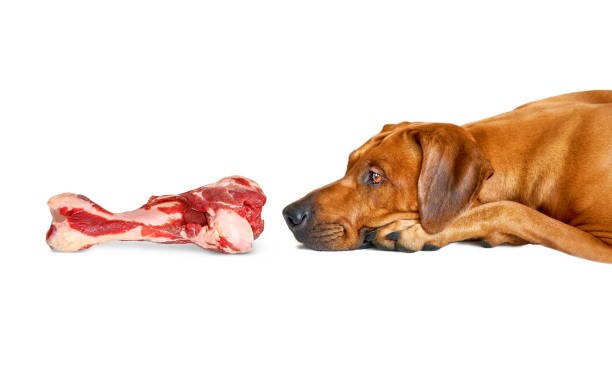
Can Dogs Eat Ham Bones? It’s a common question among pet owners, especially around holiday meals. While dogs may love the idea of gnawing on a tasty bone, not all bones are safe for them to enjoy. Ham bones, in particular, come with significant risks that every dog owner should understand.
Dogs naturally love to chew, and bones are a great way to satisfy that instinct. Chewing helps clean their teeth and provides mental stimulation, but it’s important to remember that not all bones are created equal. Ham bones, for instance, can pose serious health dangers such as choking, digestive issues, or even dangerous bacterial infections. Let’s dive into why ham bones can be harmful and explore safer alternatives to treat your dog. Let’s briefly explore that- Can Dogs Eat Ham Bones?
Can Dogs Eat Ham Bones? The Quick Answer
If you’re wondering whether you can share a ham bone with your dog, it’s important to know the risks involved. Here’s a breakdown of what you should be aware of when it comes to feeding your dog ham bones:
Cooked Ham Bones: Not Safe for Dogs
- Splintering dangers: Cooked ham bones are highly dangerous for dogs because they tend to splinter when chewed. These splinters can become sharp, making them a choking hazard or causing damage to your dog’s mouth and internal organs.
- Serious injuries: When these splinters are swallowed, they can puncture your dog’s digestive tract, leading to internal bleeding or even life-threatening injuries. This is why cooked ham bones should never be given to your dog.
Raw Ham Bones: Safer, But Still Risky
- Choking hazards: Although raw ham bones are less likely to splinter compared to cooked ones, they still present risks. A dog can easily choke if the bone breaks into large pieces or if your dog chews too aggressively.
- Digestive issues: Raw bones can also cause blockages in your dog’s digestive system if they swallow large chunks that aren’t properly broken down. Additionally, raw bones can carry bacteria, which could potentially lead to infections or digestive upset.
Always Consult a Vet
- Get expert advice: Before offering any type of bone to your dog, it’s always best to talk to your veterinarian. They can help you understand your dog’s specific needs and any health concerns that might make bones particularly risky for them.
- Vet-approved alternatives: If you’re set on offering your dog a bone, your vet might recommend safer options that are better suited for your dog’s chewing habits and overall health.
By understanding these risks, you can make the safest choices for your dog’s diet and ensure they stay happy, healthy, and safe. Always be cautious when introducing new treats like ham bones into your dog’s routine!
Understanding the Risks More Thoroughly
Feeding your dog ham bones may seem like a fun treat, but it carries serious risks that every pet owner should know. Let’s break down the specific dangers and why it’s crucial to avoid feeding ham bones to your dog.
Choking Hazard: Small Pieces Can Block the Airway
- Risk of choking: When dogs chew on bones, small pieces can break off. These pieces may become lodged in your dog’s throat, blocking their airway and making it difficult for them to breathe. In extreme cases, this can lead to suffocation.
- Signs of choking: If your dog starts coughing, gagging, or pawing at its mouth, it could be choking on a bone fragment. Quick intervention is necessary, such as performing the Heimlich maneuver or rushing your dog to the vet for help.
Splintering Risk: Cooked Bones Can Break into Sharp Pieces
- Sharp shards: When asking, “Can dogs eat ham bones?” it’s essential to know that cooked ham bones are extremely risky. They can splinter into sharp pieces, which can cause severe damage to your dog’s mouth, throat, or digestive tract. This can lead to painful cuts, infections, or internal injuries.
- Dangerous internal injuries: If the bone fragments travel down the digestive tract, they may puncture or tear the stomach or intestines, leading to serious internal bleeding, infections, or even life-threatening conditions.
Digestive Issues: Bone Fragments Can Cause Blockages or Tears
- Digestive blockages: One of the most dangerous outcomes of chewing on ham bones is digestive blockages. If your dog swallows large fragments, they may get stuck in the intestines or stomach, preventing food from passing through. This can cause pain, vomiting, and requires veterinary attention.
- Tears and perforations: Splintered bone fragments may also cause tears in your dog’s digestive tract, leading to perforations in the stomach or intestines. This condition can lead to peritonitis, a severe and life-threatening infection in the abdomen.
High Fat Content: Ham Can Lead to Pancreatitis in Dogs
- Pancreatitis risk: Ham is high in fat, which can be harmful to dogs. If a dog eats too much fat, it can develop pancreatitis, an inflammation of the pancreas. This condition is often caused by the high-fat content in ham and can result in severe pain, vomiting, and dehydration.
- Signs of pancreatitis: Symptoms include lethargy, a painful abdomen, and loss of appetite. If your dog shows any of these signs after eating ham or ham bones, seek immediate veterinary care. If left untreated, pancreatitis can become life-threatening.
As you can see, feeding ham bones to your dog is dangerous for many reasons. The risk of choking, splintering, digestive blockages, and pancreatitis are just a few of the issues that can arise from giving your dog ham bones. Instead of offering your dog these risky treats, consider safer alternatives like dog-friendly chew toys or vet-approved treats.
Why Consult a Vet? If you’re ever unsure whether a particular food or treat is safe for your dog, it’s always a good idea to consult your veterinarian. They can guide you on the safest ways to keep your dog entertained and nourished without the risk of harm. Always remember: Your dog’s health and safety should come first.
By being mindful of these risks and making informed choices, you can help ensure your dog stays safe, happy, and healthy.
Signs of Trouble You Should Look Out For
If your dog eats a ham bone, there are certain signs that may indicate they’re in trouble. Understanding these symptoms can help you act quickly and protect your dog from harm. Keep an eye out for the following signs:
Vomiting or Diarrhea
- Upset stomach: If your dog starts vomiting or having diarrhea after eating a ham bone, it could be a sign of digestive distress. Bone fragments may be irritating their stomach or intestines, leading to discomfort.
- Watch for changes: If vomiting or diarrhea continues for more than a few hours or becomes severe, it’s time to contact your vet. These symptoms may indicate that the bone has caused a blockage or injury.
Excessive Drooling or Pawing at the Mouth
- Mouth discomfort: Excessive drooling or pawing at the mouth could indicate that your dog is trying to relieve discomfort caused by sharp bone fragments. If the bone splinters in the mouth, it can cause pain or injury to the gums, teeth, or throat.
- Act fast: If your dog is constantly drooling or seems to be in distress, check their mouth for any lodged pieces or signs of injury. If necessary, get them to the vet immediately for further evaluation.
Difficulty Breathing or Swallowing
- Choking hazard: If your dog is struggling to breathe or swallow, this could be a sign that a bone fragment is stuck in their throat or airway. It’s important to act quickly to remove the obstruction if possible.
- Signs to watch for: Your dog may start coughing, gagging, or even showing signs of distress like pawing at the neck or throat. If these symptoms appear, seek immediate veterinary help.
Constipation or Bloody Stool
- Digestive blockages: Swallowing large bone fragments may cause a blockage in the intestines, leading to constipation or difficulty passing stools. This can be very painful for your dog.
- Bloody stool: If you notice any blood in your dog’s stool, it may indicate that the bone has caused internal injury or bleeding in the digestive tract. This is a serious sign and requires prompt veterinary attention.
Lethargy or Loss of Appetite
- Low energy: If your dog suddenly becomes lethargic or loses interest in food, this could be a sign that they are in pain or feeling unwell after consuming a ham bone. Digestive issues, discomfort, or internal injuries could be causing these symptoms.
- When to worry: A sudden lack of energy, combined with any of the other signs listed here, means it’s time to contact your vet for an assessment.
Can Dogs Eat Ham Bones? The Takeaway
Feeding your dog ham bones can lead to serious issues. Keep an eye out for symptoms like vomiting, excessive drooling, or difficulty breathing. If you notice any of these signs after your dog has eaten a ham bone, don’t wait—get in touch with your vet as soon as possible to ensure your dog’s health and safety.
By staying informed and watching for these signs, you can help prevent any serious harm and keep your dog happy and healthy.
Safer Alternatives to Consider
While ham bones may seem like an appealing treat for dogs, they come with serious risks. Luckily, there are safer alternatives that can satisfy your dog’s chewing needs without putting them in danger. Here are some options you can consider:
Store-Bought Chews: Dog-Safe Dental Chews or Bones
- Why they’re safe: These chews are designed specifically for dogs and are made from materials that won’t splinter or break into dangerous pieces. They can help clean your dog’s teeth and provide a satisfying chew.
- What to look for: Choose dental chews or bones that are made from natural, digestible ingredients, and ensure they are the appropriate size for your dog to prevent choking. Always read the packaging to check for any harmful chemicals.
Raw Bones: Consult Your Vet for Safe, Raw Bone Options
- Why consult a vet: If you’re interested in giving your dog a raw bone, it’s crucial to consult your vet first. Some raw bones are safer than others, and your vet can recommend the best options for your dog’s breed, size, and chewing habits.
- The benefits: When properly chosen and supervised, raw bones can provide your dog with dental benefits and help satisfy their natural chewing instincts without the risk of splintering, as long as they’re raw and unprocessed.
Vegetable Treats: Carrots or Sweet Potato Chews
- Why they’re good: Vegetables like carrots and sweet potatoes are a healthy, low-calorie alternative to ham bones. They’re safe for most dogs and provide essential nutrients.
- How they help: These veggie treats help with dental health by naturally cleaning your dog’s teeth while offering a satisfying chew. They’re also great for dogs that may have food sensitivities or are on a special diet.
Dog-Specific Toys: Durable Chew Toys Designed for Dogs
- Why they’re safe: Dog toys made from durable, non-toxic materials are another great option. These toys are designed to withstand chewing without breaking into small, sharp pieces that could harm your dog.
- What to look for: Choose chew toys that are appropriate for your dog’s size and chewing strength. Some toys even come with added benefits like being able to stuff them with treats for extra fun.
Can Dogs Eat Ham Bones? The Safe Option
While ham bones are not safe for dogs, there are many other treats and toys that can satisfy your dog’s chewing urges without risking their health. From store-bought chews to veggie treats and dog-specific toys, there are plenty of alternatives to keep your dog entertained and safe. Always consult your vet to find the best options for your dog’s specific needs.
By choosing safer alternatives, you can help prevent the dangers associated with ham bones and promote your dog’s overall health and happiness.
What to Do If Your Dog Eats a Ham Bone
If your dog has eaten a ham bone, it’s important to stay calm and act quickly. While ham bones can be dangerous, knowing what to do next can help minimize the risks and ensure your dog stays safe. Here’s what you should do:
1. Stay Calm and Monitor Your Dog Closely
- Why it’s important: Panicking won’t help, so take a deep breath. Monitor your dog for any immediate signs of distress. Keep an eye on how they’re behaving and look for any changes in their normal behavior.
- What to watch for: Keep an eye out for coughing, pawing at the mouth, or signs of pain, as these could indicate trouble caused by the bone.
2. Remove Any Remaining Bone Pieces
- Why remove them: If there are any leftover pieces of the ham bone, carefully remove them from your dog’s reach. This will help prevent them from trying to eat more bones, which can cause further injury.
- How to remove them safely: If possible, use tongs or gloves to avoid getting hurt yourself while handling sharp bone fragments.
3. Check for Signs of Distress
Look for these signs:
- Choking: If your dog seems to be choking, they may cough or struggle to breathe. This is an emergency situation that requires immediate attention.
- Vomiting or Diarrhea: These could indicate digestive issues or that the bone is causing an obstruction.
- Difficulty Swallowing: If your dog is having trouble swallowing or seems uncomfortable, it’s a red flag.
4. Contact Your Vet Immediately if Symptoms Appear
- Why it’s crucial: If your dog shows any signs of distress or if you’re unsure of how much bone they consumed, call your vet immediately. They will guide you on the next steps.
- What to expect: The vet might ask about the size of the bone and your dog’s breed to determine the best course of action.
5. Avoid Offering Similar Bones in the Future
- Why it matters: After experiencing the risks of ham bones, it’s crucial to avoid offering your dog similar bones in the future. This helps protect your dog from further harm.
- Alternatives to consider: Opt for safe dog-friendly chews, toys, or veggie treats to satisfy their chewing needs. Consult your vet for recommendations.
Can Dogs Eat Ham Bones? The Takeaway
If your dog eats a ham bone, acting quickly and carefully is essential. Monitoring your dog for distress and contacting a vet immediately can help reduce risks. Always avoid offering ham bones or similar items to your dog in the future to ensure their safety.




